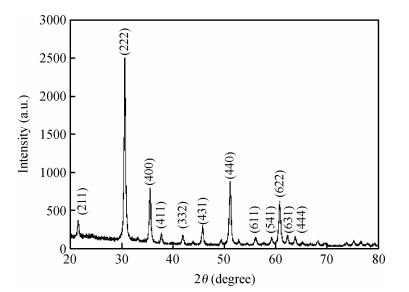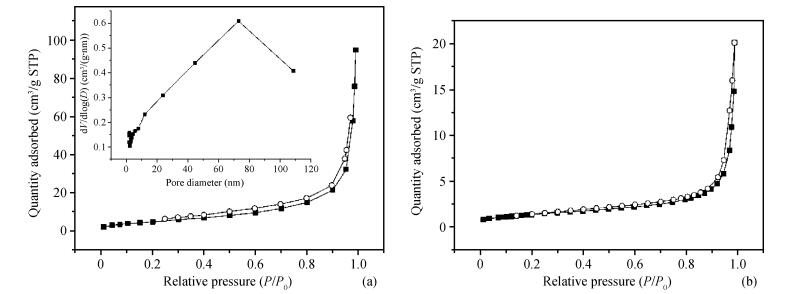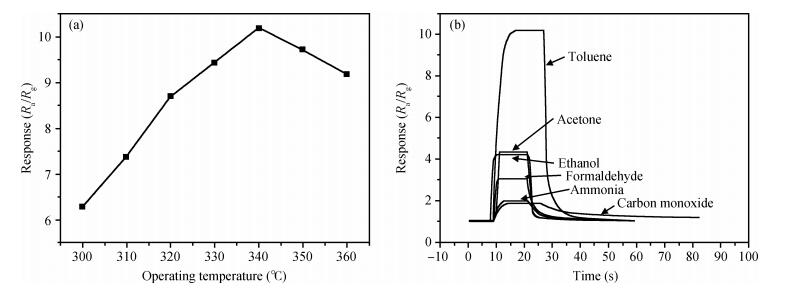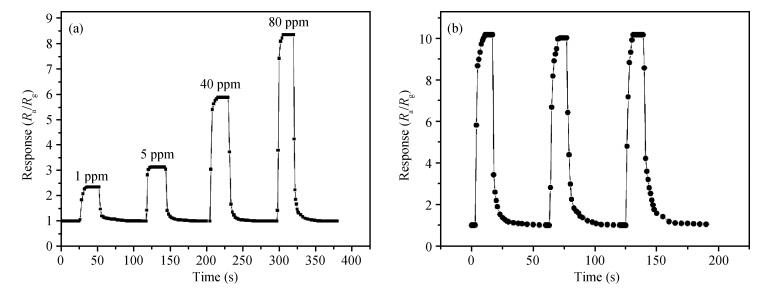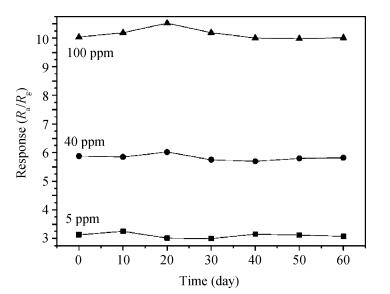| Citation: |
Xiao Chi, Changbai Liu, Jinbao Zhang, Li Liu, Haiying Li, Yue He, Xiaoqing Bo, Lili Liu. Toluene-sensing properties of In2O3 nanotubes synthesized by electrospinning[J]. Journal of Semiconductors, 2014, 35(6): 064005. doi: 10.1088/1674-4926/35/6/064005
****
X Chi, C B Liu, J B Zhang, L Liu, H Y Li, Y He, X Q Bo, L L Liu. Toluene-sensing properties of In2O3 nanotubes synthesized by electrospinning[J]. J. Semicond., 2014, 35(6): 064005. doi: 10.1088/1674-4926/35/6/064005.
|
Toluene-sensing properties of In2O3 nanotubes synthesized by electrospinning
DOI: 10.1088/1674-4926/35/6/064005
More Information
-
Abstract
The pristine In2O3 nanotubes were synthesized by electrospinning and subsequent calcination. Scanning electron microscope, X-ray powder diffraction and transmission electron micrograph were employed to analyze the morphology and crystal structure of the as-synthesized nanotubes. Gas-sensing properties of the as-synthesized In2O3 nanotubes were investigated by exposing the corresponding sensors to toluene, acetone, ethanol, formaldehyde, ammonia and carbon monoxide at 340℃. The results show that the gas sensor possesses a good selectivity to toluene at 340℃. The response of the In2O3 nanotube gas sensor to 40 ppm is about 5.88. The response and recovery times are about 3 s and 17 s, respectively.-
Keywords:
- In2O3,
- nanotube,
- toluene,
- gas sensor
-
References
[1] Pramod N G, Pandey S N, Sahay P P. Structural, optical and methanol sensing properties of sprayed In2O3 nanoparticle thin films. Ceramics International, 2012, 38:4151 doi: 10.1016/j.ceramint.2012.01.075[2] Zhao Wenjie, Shi Yunbo, Xiu Debin, et al. Sensitive properties of In-based compound semiconductor oxide to Cl2 gas. Journal of Semiconductors, 2009, 30(3):034010 doi: 10.1088/1674-4926/30/3/034010[3] Sun Peng, Hu Ming, Li Mingda, et al. Nano-WO3 film modified macro-porous silicon (MPS) gas sensor. Journal of Semiconductors, 2012, 33(5):054012 doi: 10.1088/1674-4926/33/5/054012[4] Shim H S, Kim J W, Sung Y E, et al. Electrochromic properties of tungsten oxide nanowires fabricated by electrospinning method. Solar Energy Materials and Solar Cells, 2009, 93:2062 doi: 10.1016/j.solmat.2009.02.008[5] Greiner A, Wendorff J H. Electrospinning:a fascinating method for the preparation of ultrathin fibers. Angewandte Chemie International Edition, 2007, 46:5670 doi: 10.1002/(ISSN)1521-3773[6] Zhang Z, Li X, Wang C, et al. ZnO hollow nanofibers:fabrication from facile single capillary electrospinning and applications in gas sensors. J Phys Chem C, 2009, 113:19397 doi: 10.1021/jp9070373[7] Cho S, Kim D H, Lee B S, et al. Ethanol sensors based on ZnO nanotubes with controllable wall thickness via atomic layer deposition, an O2 plasma process and an annealing process. Sensors and Actuators B:Chemical, 2012, 162:300 doi: 10.1016/j.snb.2011.12.081[8] Qiu Y, Yu J. Synthesis of titanium dioxide nanotubes from electrospun fiber templates. Solid State Commun, 2008, 148:556. doi: 10.1016/j.ssc.2008.09.047[9] Qi Q, Zhang T, Liu L, et al. Improved NH3, C2H5OH, and CH3COCH3 sensing properties of SnO2 nanofibers by adding block copolymer P123. Sensors and Actuators B:Chemical, 2009, 141:174 doi: 10.1016/j.snb.2009.05.039[10] Wagner T, Kohl C D, Morandi S, et al. Photoreduction of mesoporous In2O3:mechanistic model and utility in gas sensing. Chemistry-A European Journal, 2012, 18:8216 doi: 10.1002/chem.v18.26[11] Kim S J, Hwang I S, Choi J K, et al. Enhanced C2H5OH sensing characteristics of nano-porous In2O3 hollow spheres prepared by sucrose-mediated hydrothermal reaction. Sensors and Actuators B:Chemical, 2011, 155:512 doi: 10.1016/j.snb.2010.12.055[12] Guo L, Shen X, Zhu G, et al. Preparation and gas-sensing performance of In2O3 porous nanoplatelets. Sensors and Actuators B:Chemical, 2011, 155:752 doi: 10.1016/j.snb.2011.01.042[13] Lin C W, Chen H I, Chen T Y, et al. On an indium-tin-oxide thin film based ammonia gas sensor. Sensors and Actuators B:Chemical, 2011, 160:1481 doi: 10.1016/j.snb.2011.07.041[14] Song P, Wang Q, Yang Z. Biomorphic synthesis and gas response of In2O3 microtubules using cotton fibers as templates. Sensors and Actuators B:Chemical, 2012, 168:421 doi: 10.1016/j.snb.2012.04.054[15] Donato N, Neri F, Neri G, et al. CO sensing devices based on indium oxide nanoparticles prepared by laser ablation in water. Thin Solid Films, 2011, 520:922 doi: 10.1016/j.tsf.2011.04.182[16] Zhang Y, He X, Li J, et al. Fabrication and ethanol-sensing properties of micro gas sensor based on electrospun SnO2 nanofibers. Sensors and Actuators B:Chemical, 2008, 132:67 doi: 10.1016/j.snb.2008.01.006[17] Cheng Zhiming, Zhou Sumei, Chen Tongyun, et al. Acetic acid gas sensors based on Ni2+ doped ZnO nanorods prepared by using the solvothermal method. Journal of Semiconductors, 2012, 33(11):112003 doi: 10.1088/1674-4926/33/11/112003[18] Liu L L, Gong N M, Wei W W. Development of superfine oxidized indium powder. Chinese Journal of Nonferrous Metallurgy, 1999, 28(6):32[19] Zhang F, Wang X, Dong J, et al. Selective BTEX sensor based on a SnO2/V2O5 composite. Sensors and Actuators B:Chemical, 2013, 186:126 doi: 10.1016/j.snb.2013.05.086[20] Song X, Zhang D, Fan M. A novel toluene sensor based on ZnO-SnO2 nanofiber web. Appl Surf Sci, 2009, 255:7343. doi: 10.1016/j.apsusc.2009.02.094[21] Navale S T, Bandgar D K, Nalage S R, et al. Synthesis of Fe2O3 nanoparticles for nitrogen dioxide gas sensing applications. Ceramics International, 2013, 39:6453 doi: 10.1016/j.ceramint.2013.01.074 -
Proportional views





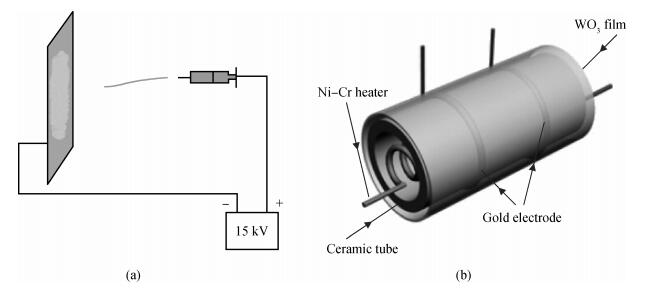
 DownLoad:
DownLoad:
